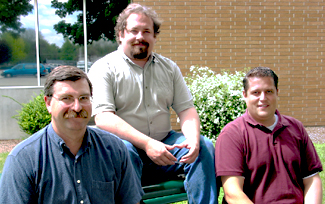
|
CONNECTIONS
|
IDAHO
ITD
HOME
IDAHO DMV
ITD NEWS
HIGHWAY
SAFETY
IDAHO STATE
POLICE
TRAVEL SERVICES
STATE OF IDAHO
NATIONAL
AASHTO
AAMVA
AAA of IDAHO
FEDERAL HIGHWAYS
FEDERAL AVIATION
IDAHO STATE POLICE
NHTSA
NTSB
TRB
U.S. DOT
Idaho
Transportation
Department
Public Affairs Office
P.O. Box 7129
Boise, ID 83707
208.334.8005
Fax: 208.334.8563
Email


ITD's
first Enterprise Architects in Training are (left to right)
Craig Schumacher, Brian Reed and Michael Bogart
Three
chosen as Enterprise Architecture trainees
consultant should be named this
summer
The Idaho Transportation Department recently took a major step forward in its adoption of Enterprise Architecture as a fundamental principle of business operations.
Bill Shaw, who was named manager of the new Enterprise Architecture Group in December, recently selected three individuals with varying backgrounds and experiences to become the first Enterprise Architects in Training (EAiT). Michael Bogart, Brian Reed and Craig Schumacher began preparing for their new assignments by researching present business practices.
Enterprise Architecture is a management/governance methodology that can be traced to the 1980s, Shaw explains. It is emerging as a tool for organizations to analyze business operations and base business decisions on technology – integrating appropriate technology into the business environment.
The new process eventually will extend to all levels and functions of the transportation department.
ITD’s adoption of the Enterprise Architecture principles dates to about 2000 when administrators of all state agencies were challenged to evaluate their operations and look for business solutions that produce greater efficiency. The search led ITD to an emerging discipline developed by retired IBM executive John Zachman. He had been focusing on information strategy and architecture for more than three decades.
His model brings business decisions and the use of appropriate technology together in an integrated, interwoven process, which is exemplified by the department’s first three Enterprise Architects in Training.
Bogart had been engaged in web development on a broad level for ITD until recently joining the AMS implementation project. The new financial management system should be introduced later this year, replacing the financial system provided by Oracle. His experience on the implementation team will prove invaluable experience and expertise in development of the Enterprise Architecture process.
He expects to continue on the AMS implementation team until a suitable replacement is identified.
Reed was a math analyst in the Division of Planning until he entered the Enterprise Architecture boot camp and was selected for his new position last month. He was involved in the enterprise data model of the information technology strategic plan. Since his recent appointment, Reed has been identifying the resources available in the transportation department and determining how they might be integrated into the new model.
It is important to build on the available resources when possible rather than systematically discarding them, he explains. Understanding the gap between what we have and where we’re heading is important.
Shaw agrees.
“Decisions need to be made on the full knowledge of what you have, so you can more clearly map to where you want to go.”
Schumacher is making his own transition, from administrator
of the department’s Microsoft Exchange mail server to the new
EAiT position. He is training Greg Christiansen to assume his former
role. He and his two EAiT colleagues have been immersing themselves
Enterprise Architecture, preparing for the arrival of a consultant early
this summer.
ITD is soliciting proposals from prospective EA consultants and hopes
to have one identified early this summer. The consultant will help guide
development of ITD’s new business/technology model.
“The department recognizes that it doesn’t
have the skills or expertise to create the Enterprise Architecture framework,”
Shaw explains. “The consultant will do the work and transfer the
knowledge to our employees, training and mentoring us. The consultant
is intended to be a bridge until we develop sufficient competencies
within our own staff.”
Shaw says Enterprise Architecture is an emerging tool that will have
significant impact in areas yet to be identified.
“(EA) is just now beginning to catch on as a management/governance methodology, It really only started to break out in about the last five years, but it is becoming part of mainstream business. We’re ahead of the rest of the state in developing Enterprise Architecture. Although we may lag behind industry leaders, our understanding is well advanced and our implementation will be state-of-the-art.”
ITD is the only department in Idaho state government and is one of only about four state transportation departments nationally to adopt EA principles. The federal Office of Management and Budget has adopted Enterprise Architecture as a condition for each federal agency to receive funding. But the agencies are rapidly maturing in their use of Enterprise Architecture throughout their business processes,” Shaw explains.
He doesn’t anticipate the architects in training to develop areas of specialty; instead, they will serve as generalists who work with all ITD disciplines. They will serve as a resource for ITD sections that need to bring information technology solutions to their business operations.
“Specialization is not a goal of Enterprise Architecture,” Shaw says. “It’s an evolution of skills that will provide services across the department. We’re small enough that our Enterprise Architects will be cross-knowledgeable. We’re all going to be learning much the same things the first year… all diving into the same things.
“To really succeed with enterprise Architecture, we need to have cooperation and embracing. It needs a strong governance component – which we have in place.”